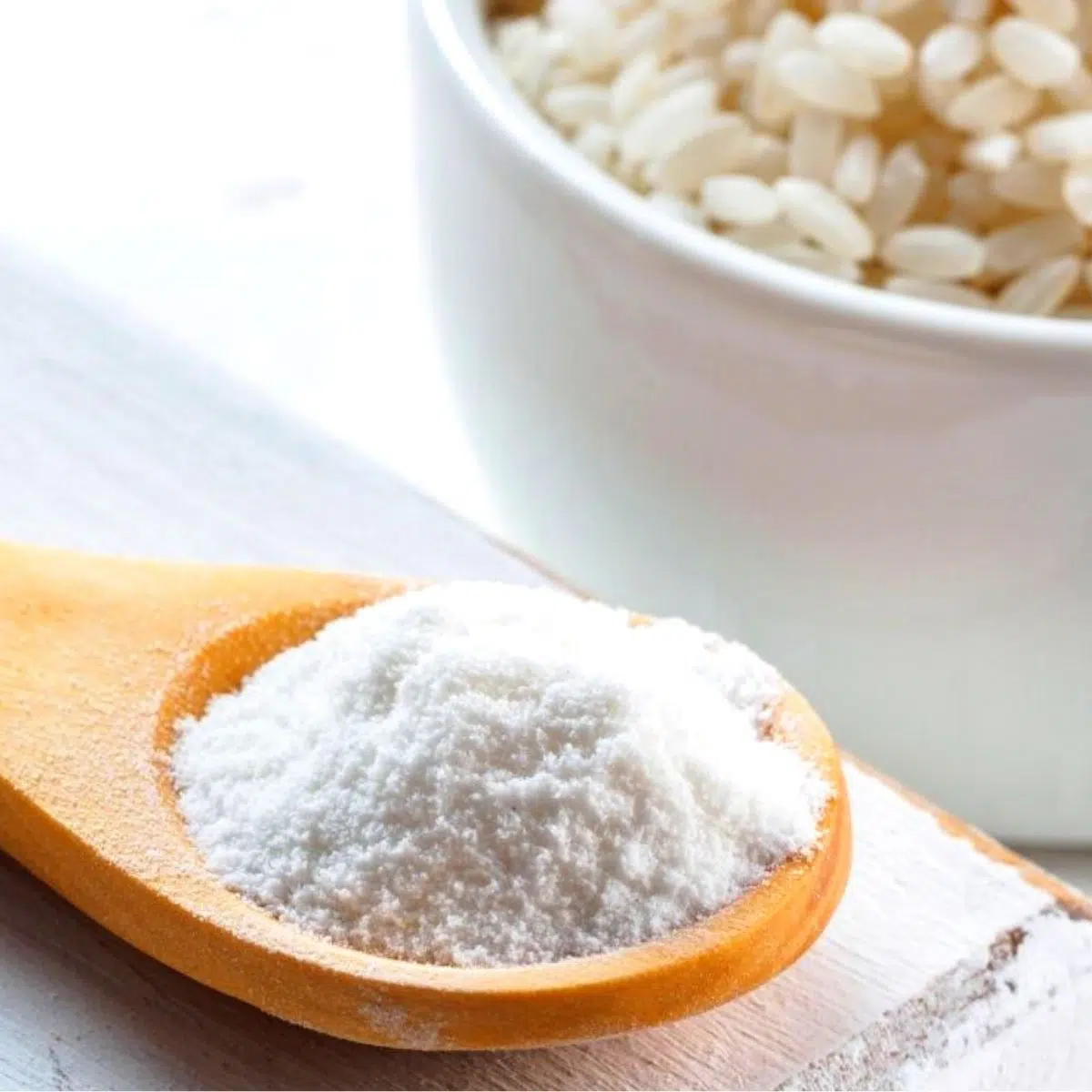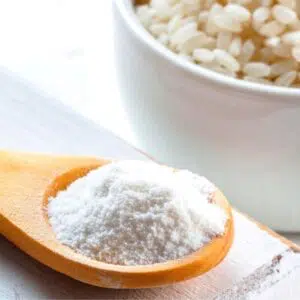If you need a great rice flour substitute for your recipe, you're in luck - this handy guide will help you find an alternative you have on hand! We're sharing all of the very best options for cooking, frying, and baking up your fave recipes that usually use rice flour!

Amazingly versatile rice flour is also super easy to find great alternatives for!
The word “flour” simply describes the powder that comes from grinding a grain. Most of us associate this with wheat. However, flour can be made from any type of grain (and even legumes and nuts).
As gluten-free diets have become more prevalent, alternatives to wheat flour have become more popular. Rice flour is one of those popular gluten-free flours.
Jump to:
- What is Rice Flour Used For?
- The Best Substitutes for Rice Flour
- 1. Cornstarch
- 2. All-Purpose Flour
- 3. Cake Flour
- 4. Almond Flour
- 5. Tapioca Flour
- 6. Potato Starch
- 7. Oat Flour
- 8. Sorghum Flour
- 9. Buckwheat Flour
- 10. Chickpea Flour
- 11. Millet Flour
- 12. Coconut Flour
- 13. Arrowroot Powder
- 📖 Recipe Card
- 💬 Comments & Reviews
Even though rice flour may be more popular than it has in previous years, it is still not as common as wheat flour. Therefore, if you have a recipe that calls for rice flour you may not already have it on hand.
Moreover, depending on where you live, you may not have access to a specialty store that sells it.
Whether you can’t find rice flour or just ran out mid-recipe, there are several substitutes that will give you a similar result!
What is Rice Flour Used For?
Even though rice flour has become popular in the United States as a gluten-free flour option, it has always been a staple in Asian and Indian cooking. Therefore, you may find yourself needing to use rice flour in a traditional recipe from one of these areas.
In addition, you may want to use rice flour as a substitute for wheat flour. It is a great choice for thickening stews, soups, and sauces. It also makes tasty quick breads, cakes, and other non-yeast baked goods.
Unfortunately, it cannot be used to replace wheat flour in recipes that call for a rising agent such as yeast though.
The Best Substitutes for Rice Flour
There are a lot of really great alternatives that are easy to use as a replacement for rice flour in both cooking and baking! With all of these substitutes to choose from, you're sure to have something on hand to complete your tasty recipe!
1. Cornstarch
As another common gluten-free ingredient used as a thickening agent, cornstarch is an excellent substitute for rice flour. It also works for deep frying!
Not only is cornstarch gluten-free, but it is also flavorless. Therefore, it will not impact the taste of your recipes.
As a substitute for deep frying, cornstarch can be used in the exact same way as rice flour. Simply cover your desired food with a thin coating and fry to your desired crunchy texture.
However, while rice flour can be added dry to thicken soups and sauces, cornstarch needs to be made into a slurry first. To make a slurry, place your measured cornstarch in a small bowl.
Add about 2x the amount of water and mix. Slowly pour the slurry into your sauce or soup and stir to thicken.
While cornstarch can be used in an easy 1:1 ratio for rice flour, you may not need the entire bowl of slurry. Simply use as much as you need to get the desired thickness.
2. All-Purpose Flour
If you have a recipe that calls for rice flour, but you are not cooking for anyone with a gluten allergy, then regular wheat flour is an amazing substitute. It works for thickening soups and sauces, frying, and baking!
When using all-purpose flour as a thickening agent, you will need to make a slurry the same way you would with cornstarch. Just like with cornstarch, measure the equal ratio to make the slurry but only use as much as needed.
When using all-purpose flour for frying, use it the exact same way the recipe calls for. You can also use it exactly as the recipe calls for in baking.
All-purpose flour will provide a delightful crunchy outside when used for frying. In baking, the gluten in all-purpose flour will provide a lighter and less dense texture to baked goods (than if made with rice flour).
Measure all-purpose flour in a 1:1 ratio for all recipes.
3. Cake Flour
Cake flour is also made from wheat. It is almost the same as all-purpose flour with a small difference in the protein content in the flour.
This small difference makes for a light and fluffy cake, hence why it is called cake flour. If you bake regularly, you may have cake flour on hand.
While not ideal for thickening or frying, it was made for baking. Therefore, you can easily substitute it for rice flour in any baking recipe.
Substitute cake flour for rice flour in a 1:1 exchange.
4. Almond Flour
While almonds are not a grain, they do form a similar powder to grain-based flours. Therefore, they are a great gluten-free substitute for many flours – including rice flour!
With a slightly nutty flavor and a grainier texture than rice flour, almond flour is best used for baking. When used in baking it offers a lovely texture and taste to everything from sweet treats to quick breads.
It also takes on the flavor of many other ingredients; therefore, the nutty flavor is not too pronounced.
Beyond baking, almond flour can be used as a thickener. However, the taste and texture are not ideal for many soups and sauces.
Furthermore, since almond flour burns quickly it is best to avoid using this for frying.
The great thing about subbing almond flour for rice flour is that it is an easy 1:1 exchange in any recipe.
5. Tapioca Flour
Tapioca isn’t just for your grandma’s favorite pudding. This starchy by-product of the cassava root can be used in lots of ways in the kitchen.
While frying is not one of the great ways tapioca flour can be used, it is excellent for thickening and baking.
Tapioca flour has a similar consistency to rice flour which makes it easy to use as a substitute. While it is slightly sweeter than rice flour, its overall taste is quite mild.
Therefore, it can be used in most recipes without affecting the overall taste too much.
The one drawback when subbing with tapioca flour is that you need 2x as much. However, it is one of the least expensive gluten-free flours, so it seems to balance out.
Use tapioca flour in a 2:1 ratio for rice flour (2 cups of tapioca flour for 1 cup of rice flour) for baking and thickening.
6. Potato Starch
While there is both potato flour and potato starch, you want to use potato starch as a substitute. Like cornstarch (except made from potatoes), it works in the same way as a substitute for rice flour.
Potato starch is much starchier than rice flour (and cornstarch) though. Therefore, it thickens more quickly so you only need a small amount.
Make a slurry using one tablespoon of potato starch + 2 tablespoons of water. This will be enough to thicken about 1 cup of liquid.
As a coating for frying foods, you can use a 1:1 exchange of potato starch for rice flour.
7. Oat Flour
Oat flour is a substitute that sometimes gets overlooked, but it is an excellent ingredient! It is also a super easy one to make at home in a pinch.
If you need a quick substitute for rice flour, just toss some raw oats in a food processor and blend away. Once you have finely ground oat flour you can use it as a substitute for rice flour.
Oat flour has a similar flavor profile to rice flour and works well in baking and as a thickening agent. While most oats and oat flours are gluten-free, not all of them are made in gluten-free spaces.
So, make sure to double-check the label if you need a guaranteed gluten-free ingredient.
Oat flour can be used in a 1:1 exchange for rice flour.
8. Sorghum Flour
While it hasn’t made its way into every home kitchen, sorghum flour has been a popular ingredient in gluten-free commercial kitchens for a while now. It is a common alternative for all-purpose flour when making gluten-free breads and other baked goods.
It is also an equally great substitute for the already gluten-free rice flour. While it has a similar bitter taste to rice flour, it is a bit stronger.
As a baking substitute, sorghum flour takes on the other flavors surrounding it. However, on its own for frying or thickening, the flavor can be overpowering.
Use this easy substitute in a 1:1 exchange for rice flour.
9. Buckwheat Flour
Buckwheat flour has a nutty and earthy taste that is similar to rice flour. It is also gluten-free.
A great thing about buckwheat flour is that while it is gluten-free, it has a similar protein ratio to wheat flour. This allows for a wonderful texture in baked goods that is not quite as dense as some other gluten-free flours.
Buckwheat flour is a tasty substitute for baked goods, especially morning muffins, pancakes, or waffles.
Use buckwheat flour in a 1:1 substitution for rice flour.
10. Chickpea Flour
Chickpea flour is not as common as other gluten-free types of flour. If you are looking for a long-term alternative to rice flour though, consider looking for this at your local health food store.
Made from grinding up chickpeas (aka garbanzo beans) this alternative offers a higher protein than some other gluten-free flours. Its earthy flavor is best used in baking, as it takes on other flavors surrounding it.
Use in a 1:1 exchange for rice flour in baking.
11. Millet Flour
Of all the flour substitutes, millet flour is one that is lower on the list of best options. It is an acceptable one to use though when you are in a bind (and if you already have it in your kitchen).
Ground millet produces a similar taste to brown rice. Therefore, this can be a good choice for recipes that specifically call for brown rice flour.
Best used in baking, replace rice flour with an equal 1:1 substitution of millet flour.
12. Coconut Flour
Another common gluten-free flour, coconut flour can be used as a substitute for rice flour. However, coconut flour on its own absorbs moisture very quickly. This means that it's best used when combined with other gluten-free flours (or arrowroot powder).
Coconut flour is also sweeter than rice flour. Combined with its texture, these are two reasons it is best used as a baking substitute.
If using coconut flour on its own, begin by using half the amount of what the recipe calls for in rice flour (consider adding an extra egg or ¼ cup of liquid as well to help with the texture). If it doesn’t look quite thick enough, then slowly add more flour.
In addition, try making a 50/50 mix of coconut flour and almond flour to replace the rice flour (½ cup of coconut flour + ½ cup of almond flour = 1 cup of rice flour).
13. Arrowroot Powder
Arrowroot powder is a popular thickening agent for those who want to avoid corn-based products. With the same properties as cornstarch, it can be used as a similar substitute for rice flour.
Use arrowroot to thicken soups, sauces, and stews. You can also use it to dredge meats and veggies for frying.
In addition, arrowroot can be used for baking when combined with gluten-free flour. The ratios will vary depending on the recipe and the flour you are using.
Therefore, you may need to play around to find the exact measurements for the texture you prefer. Using ¼ cup of arrowroot powder as part of a 1 cup substitution is a good place to begin though (¼ cup + ¾ cup gluten-free flour).
If you happen to just be low on rice flour though, you can sub the remaining volume with arrowroot (for example, ¾ cup rice flour + ¼ cup arrowroot powder for 1 cup rice flour).
We hope that you have found this complete list of rice flour substitute and alternative ideas handy for your cooking and baking! Be sure to drop us a comment below and let everyone know what worked best for you!
Do you love a recipe you tried? Please leave a 5-star 🌟rating in the recipe card below and/or a review in the comments section further down the page.
Stay in touch with me through social media @ Pinterest, Facebook, Instagram, or Twitter! Subscribe to the newsletter today (no spam, I promise)! Don't forget to tag me when you try one of my recipes!
📖 Recipe Card
Best Rice Flour Substitute: Cornstarch, All-Purpose Flour (+More Great Alternatives!)
Ingredients
Option 1 - Cornstarch (gluten-free)
- 1 tablespoon cornstarch
Option 2 - All-Purpose Flour
- 1 tablespoon all-purpose flour
Option 3 - Tapioca Flour (gluten-free and corn-free)
- 2 tablespoon tapioca flour
(Note: 2x or 3x only changes the ingredient list)
Instructions
Option 1 - Cornstarch (gluten-free)
- Use cornstarch as a breading in a 1:1 ratio, or make a slurry to thicken your soup, stew, sauce, or gravy. To make a slurry, combine 1 tablespoon cornstarch with an equal amount of cold water. Mix then whisk into your liquids.
Option 2 - All-Purpose Flour
- Use all-purpose flour in an equal 1:1 ratio as well. Make a slurry as directed above to thicken liquids.
Option 3 - Tapioca Flour (gluten-free and corn-free)
- Use tapioca flour in a doubled 2:1 ratio to the rice flour called for in any recipe.



Jolinda Rockett says
Angela, you saved my bacon (or should I say my popovers!). I was preparing to make 3 dozen gluten-free popovers before a shindig tonight but I only had a tiny bit of rice flour. I made substitutes based on your advice and what I had in the pantry and, whew. It turned out just fine. Good, actually. Love the thorough explanations. You're the best. Jolinda
Mickey Elkins says
I am retired and have been trying to learn how to cook dishes beside the ones I grew up eating. I find myself at a disadvantage not knowing a lot of the terms used and knowing what can be substituted for an ingredient called for in a recipe. Thank you for shedding a little light on a few of these. I wanted to prepare a dish which called for rice flour, and I couldn't find it in any of the local retailers in my area. So tomorrow I shall attempt my recipe. Thank you for assisting me on my quest to become an acceptable cook.
Terry Quinn says
This list was so helpful. Thanks